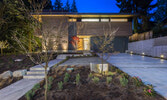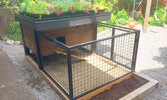Orcas: The inspiration behind Blackfish Homes and Built Green Canada Board Chair
British Columbia’s Johnstone Strait, north of Vancouver Island, is home to around 150 orcas during the summer months. Though they’re commonly known as “Killer Whales”, they are the largest member of the dolphin family and in fact not whales at all. They have gained recent attention under the name the First Nations’ people of the area gave to them: Blackfish. 400 km south is the neighboring city, North Vancouver, home to Blackfish Homes.
Owner and Director of Sales, David Adair, was once an ocean guide on a kayaking tour along the Johnstone Strait. He admired the incredible Orcas—particularly their strong communication skills and family ties. Years later, when founding his company, he identified these as values the company would strive to embody—and so became Blackfish Homes.
Proponents of conservation, David who is current Built Green Canada Board Chair, and fellow owners, Robert Griesdale and Stuart Sanders, wanted to ensure they were producing quality, high-performance homes, so in 2009, they started building to BUILT GREEN® certification.
Built Green Canada’s environmental programs make sense for builders like Blackfish Homes, who want to enable their customers to make informed decisions about their family house. The BUILT GREEN® program looks at the house as a system, including energy efficiency, as well as the preservation of natural resources, reduction of pollution, ventilation and air quality, and the improvement of home durability. Blackfish Homes utilize the advanced building technologies of building science, creating optimal living conditions without the footprint of a regular home.
The misconception that you have to sacrifice luxury to be environmentally conscious is one Blackfish Homes dispels with each build. Sustainable development is about making smart, informed decisions—something Built Green and Blackfish focus on; for instance, the use of safe, sustainable materials, without harmful chemicals that pollute the home’s air.
Though safe materials would seem an obvious choice, there are many commonly used building products containing chemicals proven harmful (like toxic formaldehyde). Further, homeowners can unknowingly bring in materials with harmful offgasing, like certain furniture, flooring, and paint. Built Green encourages builders to go a step further than simply using zero formaldehyde products to utilizing products that actually absorb airborne volatile organic compounds (such as formaldehyde), cleaning your indoor air.
Homeowners may not be thinking of how building materials can make a difference to their health, which demonstrates the fundamental difference in using a sustainable builder: They’re thinking of these things so you don’t have to—and your home’s luxury only increases with your improved health. A quick scroll through Blackfish Homes’ online gallery shows they’re committed to innovative design alongside functionality. Building green isn’t about cutting luxury so much as it is about improving health—for the environment and the homeowner.
For Blackfish, David says it’s all about performance—naming energy efficiency, air quality, and the overall environmental footprint. The BUILT GREEN® program helps them achieve this end result, focusing on seven areas: energy efficiency; materials and methods; indoor air quality; ventilation; waste management; water management; and business practices. Customers often believe going green means massive cost, but David says, “If it is done smart, it doesn’t blow the budget,” estimating that the expense of the sustainability features is approximately two to three per cent of the home’s total cost, which are redeemed in future utility bills.
With affordability continuing to be a major concern in home ownership, conservative utility bills become increasingly important. This increased home performance, combined with increased comfort for homeowners, has made the Blackfish staff enthusiastic about BUILT GREEN® certification. Though it took some time to get “the family” (Blackfish staff) on board, the “why” of BUILT GREEN® became obvious as staff noticed improved performance on their homes. As increased energy standards came into effect in December 2014, David says Blackfish found themselves four to five years ahead of industry. Many builders found themselves scrambling to meet the new code, but as an industry leader in sustainability, and one of the few builders in the area doing sustainable building, Blackfish Homes are still performing well above code, meaning a superior home for their customers.
At home, sustainability remains an important topic, in which David engages his daughters. To have children learning and becoming invested in the environment early on gives hope to a future of guardianship and innovation. Not surprisingly, rivers and inlets and the importance of water conservation are emphasized in their home. David explains to his girls that the water they use in their home is from the rivers; therefore, water conservation impacts fish and their habitat—and eventually the oceans, where these rivers drain.
David’s stress on environmental responsibility extends to urban farming. The family opted for backyard chickens so they could produce their own, more healthy eggs. They built their backyard chickens a luxury, insulated hen house, dubbed “The Fowlmont Hotel ”. The Fowlmont has a green roof, adorned with a garden, to keep their beautiful assortment of hens cool in the summer and warmer in the winter. A floor cage allows waste to fall beneath for removal, keeping their little flock clean and healthy. A built-in ladder offers the hens mobility between the Fowlmont and their outdoor run. Through this family initiative, David also takes the opportunity to teach the girls about where their food comes from as well as recycling organics through urban farming.
To David, sustainability, whether practiced at home or when building a home, is much like preventative medicine: it’s about protecting, promoting, and maintaining health of the environment and the individuals living there.


